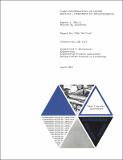| dc.contributor.author | Wilcox, Stanley James | en_US |
| dc.contributor.author | Rohsenow, Warren M. | en_US |
| dc.contributor.other | Massachusetts Institute of Technology. Division of Sponsored Research. | en_US |
| dc.contributor.other | Massachusetts Institute of Technology. Dept. of Mechanical Engineering. | en_US |
| dc.contributor.other | Massachusetts Institute of Technology. Heat Transfer Laboratory. | en_US |
| dc.date.accessioned | 2011-03-04T23:21:17Z | |
| dc.date.available | 2011-03-04T23:21:17Z | |
| dc.date.issued | 1969 | en_US |
| dc.identifier | 14083416 | en_US |
| dc.identifier.uri | http://hdl.handle.net/1721.1/61430 | |
| dc.description.abstract | Major differences exist in results published by investigators of film condensation of liquid metal vapors. In particular, the reported dependence of the condensation coefficient on pressure has raised questions about both the precision of the reported data and the validity of the basic interphase mass transfer analysis. An error analysis presented in this investigation indicates that the reported pressure dependence of the condensation coefficient at higher pressures is due to an inherent limitation in the precision of the condensing wall temperature measurement. The magnitude of this limitation in precision is different for the various test systems used. The analysis shows, however, that the primary variable affecting the precision of the wall temperature measurement is the thermal conductivity of the condensing block. To verify the analysis, potassium was condensed on a vertical surface of a copper condensing block. The copper block was protected from the potassium with nickel plating. Condensation coefficients near unity were obtained out to higher pressures than those previously reported for potassium condensed with stainless steel or nickel condensing blocks. These experimental results agree with the prediction of the error analysis. In addition, a discussion of the precautions used to eliminate the undesirable effects of both non-condensable gas and improper thermocouple technique is included. It is concluded from the experimental data and the error analysis that the condensation coefficient is equal to unity and that the pressure dependence reported by others is due to experimental error. | en_US |
| dc.description.sponsorship | Sponsored by National Science Foundation | en_US |
| dc.format.extent | 120 p | en_US |
| dc.publisher | Cambridge, Mass. : M.I.T. Engineering Projects Laboratory, Dept. of Mechanical Engineering, [1969] | en_US |
| dc.relation.ispartofseries | Technical report (Massachusetts Institute of Technology, Heat Transfer Laboratory) ; no. 62. | en_US |
| dc.subject | Liquid metals. | en_US |
| dc.subject | Condensation. | en_US |
| dc.subject | Potassium. | en_US |
| dc.title | Film condensation of liquid metals -- precision of measurement | en_US |
| dc.type | Technical Report | en_US |
